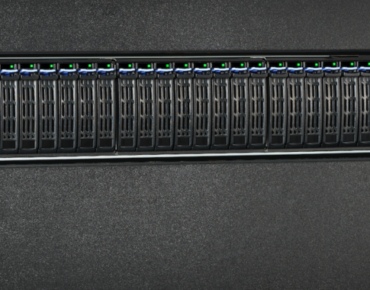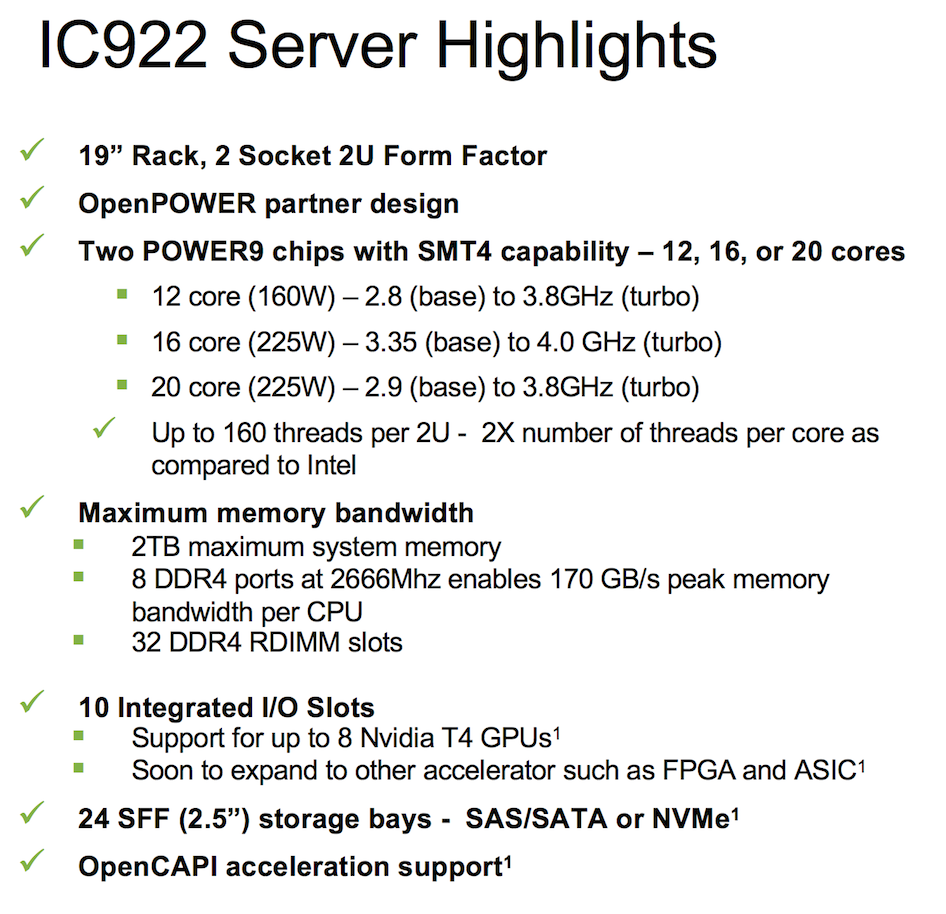IBM Launches Power Server for AI Inferencing, Data Management

IBM IC922 Inference Server
IBM today launched a Power9-based inference server – the IC922 – that features up to six Nvidia T4 GPUs, PCIe Gen 4 and OpenCAPI connectivity, and can accommodate up to 24 SFF drives in a 2U form factor. Paired with IBM’s AC922, which uses Nvidia V100 GPUs, IBM says it now offers a complete solution for AI workloads encompassing data management, training and inferencing. IBM also says the new IC922 is priced at parity or better than comparable x86-based offerings.
The use of T4 GPUs leverages Turing Tensor cores for their varied mixed precision capabilities (FP32, FP16, INT8, INT4) best suited for inferencing and T4’s lower cost. Taken together, this helps IBM attack what analysts say is the fastest growing AI market segment and likely to become the largest by volume. By contrast, the AC922 leverages Nvidia V100 GPUs, which are better suited for traditional HPC and AI training workloads and more costly. The AC922 is famously built using the same architecture as Summit supercomputer, currently the fastest supercomputer in the world as ranked by the Top500 List (November 2019).
 “The IC922 is focused on data, inferencing and cloud,” said Dylan Boday, IBM director of offering management, cognitive and scale-out systems, in a pre-briefing with HPCwire. “We’ll be able to drive up to 24 small form factor drives, and including in the not too distant future, 24 NVMe drives. When you combine 24 NVMe drives plus PCIe Gen 4 out to your network you have a very powerful story from a balanced perspective.
“The IC922 is focused on data, inferencing and cloud,” said Dylan Boday, IBM director of offering management, cognitive and scale-out systems, in a pre-briefing with HPCwire. “We’ll be able to drive up to 24 small form factor drives, and including in the not too distant future, 24 NVMe drives. When you combine 24 NVMe drives plus PCIe Gen 4 out to your network you have a very powerful story from a balanced perspective.
“At the rack level you get very high throughputs. This is interesting for AI because many people are starting to look at storage deployments and their tier hierarchy. You need ‘warm’ or low latency access to some storage capabilities. Secondly, launching it with up to six T4 Nvidia GPUs gives the clients flexibility [and] in the very near future we’re going to be going to eight [T4s], which will give you 33 percent better GPU density, than HP or Dell servers will be able to do in a 2U server.”
IBM also argues it’s able to leverage its threads-per-core advantage both generally and for container performance.
The new system will be available on February 7. IBM reports it is still “investigating expanding IC922 into the IBM public cloud in the future.” Official announcement of the IC922 came in a blog (Complete your AI puzzle with inference) today by Grace Liu, principal offering manager, Linux Infrastructure.
IBM has been promising a renewed product push in AI and the IC922 is likely just the first. “Our Linux focus market is one that is [delivering] a portfolio for the AI era,” Boday said. Many AI projects are failing, he contends, and one reason is the difficulty making the transition from a controlled training environment to the more chaotic data ingest and inference environment where compute requirements and skills are different. The IC922, he said, is optimized for inferencing and data management and will make the transition easier. Its modular design allows organizations to scale infrastructure to meet needs whether on- premises or in a private cloud environment.
Software, of course, is another key. At SC19, IBM promoted its Bayesian software expertise as an AI enabler. In conjunction with the IC922 announcement, Boday said, “We’re going to introduce an inferencing software [it] basically allows you to operationalize your inferencing.” Few details were discussed at the briefing and in response to an emailed question about those plans, IBM responded, “IBM believes that just as training required specialized software, so does AI inference. Our Watson Machine Learning Accelerator product family continues to evolve to leverage the latest capabilities of IBM Power Systems for AI, and we expect that to continue for inference.”
That sounds like a stay tuned message. Shown below are top line bullets from the official announcement:
While the immediate IC922 focus is on using T4s, IBM noted plans to support other accelerator types.
“I’m not going to discuss all the details,” said Boday. “There are some statements of direction around FPGAs from Xilinx and other ASIC capabilities, as those devices are moving to PCIe Gen 4. This is kind of that future-proof box, if they want to start to leverage an FPGA as an inferencing, or even a training device. There are hundreds of different acceleration capabilities coming into the market quite rapidly. This system should be able to capture them. As clients demands increase we’re able to respond in an agile method to add those to our server, and provide the best-of-breed solution for those types of acceleration capabilities.”
Unlike the AC922, which offers NVLink for CPU-GPU communication, the LC922 uses PCIe 4. “In AC922, we have NVLink – that’s because of the form factor and the capabilities built into the Nvidia Volta. There’s less demand on overall throughput to these types of [training systems],” said Boday. IBM chose to leverage PCIe density advantages for the IC922 and to provide OpenCAPI capability for future devices. In recent months there has been a fair amount of discussion around OpenCAPI and the newer CXL standard led by Intel with speculation around bringing compatibility between the two.
Boday said, “CXL is not a commercially viable technology at this point. What I would say is CXL is definitely on our radar. We have a board seat within the CXL Foundation. So as that gets more and more traction, we’re going to have a significant voice of influence there. I would argue that IBM [started activities] for coherence in acceleration several years ago with CAPI and OpenCAPI. Speaking to this box, specifically, it will have OpenCAPI capabilities. This is actually the first box that has OpenCAPI capabilities commercially available, and what we’ll see is the ability for developers to start to leverage a coherent, high throughput, low latency interface for all kinds of new devices.”
IBM reports it will soon have a developer board. “One of the first things we’re going to do is enable the marketplace with a Bittware FPGA-based a card. It’ll be available in the near future as well. That allows developers to take advantage of the low latency/high throughput, and then we’ll even have a card for them to start exploring on that as well in the very near future.”
How the new offering fits into the broader AI go-to-market strategy articulated by IBM exec Dave Turek at SC19 isn’t entirely clear. He suggested a strategy in which IBM would provide smaller AI systems able to leverage a client’s existing infrastructure to improve system and application performance. (For more see HPCwire article, SC19: IBM Changes Its HPC-AI Game Plan).
Liu wrote in her blog, “To showcase how the IC922 fits into the AI puzzle, the Department of Defense High Performance Computing Modernization Program (HPCMP) recently demonstrated how the IC922 and AC922 could be combined into a modular computing platform, creating an IBM POWER9-based supercomputer in a shipping container. This modular computing capability, initially installed at the U.S. Army Combat Capabilities Development Command’s Army Research Laboratory DoD Supercomputing Resource Center, will enable the DoD to redefine the term ‘edge’ to include deployment of an AI supercomputing capability anywhere in the world, including the battlefield.”
In a sense, this use of edge could encompass deployments similar to what Turek suggested in which IBM brings an AI cluster – as small as a single node, said Turek – to enhance performance of infrastructure already in place. He also implied IBM would offer AI systems specialized around specific functions such as security and systems management. Perhaps that’s a next step, with AC922-IC922 combinations offered to “supercharge” existing infrastructure.
Link to IBM blog: https://www.ibm.com/blogs/systems/complete-your-ai-puzzle-with-inference/











